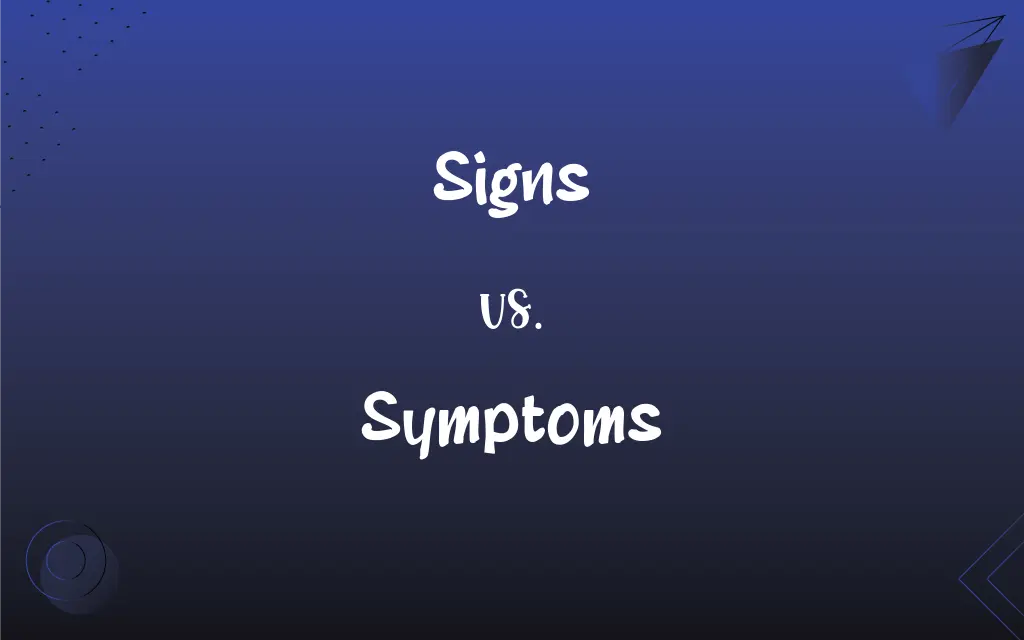Signs vs. Symptoms: What's the Difference?
Edited by Aimie Carlson || By Harlon Moss || Updated on October 11, 2023
Signs are observable indications like a rash, while symptoms are subjective experiences, such as pain, only felt by the patient.

Key Differences
Signs in a medical context refer to objective evidence of a disease perceptible to the examining physician. Notably, signs can be visually observed, measured, or detected during a medical examination without information from the patient. For example, a fever, high blood pressure, or an abnormal blood test indicates an underlying medical condition, illustrating how signs serve as tangible, verifiable evidence of health states, which assist health care providers in diagnostic processes.
Symptoms, in contrast, lean on the subjective side of medical diagnostics and are typically described by the person experiencing them. Symptoms are not as readily observable as signs and heavily rely on patient feedback and communication. A patient may describe a headache, fatigue, or anxiety—all examples of symptoms. Crucial to note is that symptoms necessitate patient input to be identified, and they are critical in understanding how a patient experiences a particular medical condition.
Elaborating further on signs, these can be categorized into two types: vital and telltale. Vital signs include fundamental, easily measurable physiological functions such as pulse and breathing rate, temperature, and blood pressure, which offer immediate insights into a patient’s basic bodily functions. Telltale signs, conversely, provide direct indications of a specific disease or disorder and may emerge through specialized tests or under specific circumstances, illuminating how signs encompass a wide range of observable phenomena in medical practice.
Diving deeper into symptoms, it’s noteworthy to emphasize that symptoms can be further distinguished into acute, chronic, and relapsing. Acute symptoms appear and change swiftly, such as the abrupt onset of pain. Chronic symptoms persist over a prolonged period, like continuous pain lasting for months, while relapsing symptoms are those that fade and recur, highlighting the nuanced experiences patients may articulate through symptoms. Therefore, an adept healthcare provider often meticulously interweaves their understanding of both signs and symptoms to render a comprehensive diagnosis and treatment plan.
Lastly, understanding the interaction between signs and symptoms becomes crucial in forming diagnoses and managing care. Both entities intertwine in the realms of healthcare, presenting a picture of a patient’s health that, when considered together, provides a robust base for medical decision-making. The astute clinical understanding and the synthesis of signs and symptoms facilitate the precision of diagnosis, prognosis, and ultimately the management and treatment of a patient, reflecting the paramount importance of both concepts in the realm of healthcare.
ADVERTISEMENT
Comparison Chart
Nature
Objective, observable indicators
Subjective experiences
Detection
Identified by healthcare providers
Described by the patient
Measurement
Can be measured and quantified
Cannot be quantifiably measured
Dependence
Independent of patient feedback
Depend on patient description
Example
Fever, rash, altered heart rate
Pain, dizziness, anxiety
ADVERTISEMENT
Signs and Symptoms Definitions
Signs
In medicine, signs are objective, observable manifestations of a disease or disorder.
The doctor noted the signs of an infection in the form of a high fever and swollen lymph nodes.
Symptoms
Symptoms can represent the manifestations of a malfunction in mechanical or electronic contexts.
The strange noises coming from the engine were worrying symptoms of a possible malfunction.
Signs
In astrology, a sign can denote one of the 12 divisions of the zodiac.
Her astrological sign is Gemini, which is known for its duality and communicative nature.
Symptoms
In discussions, symptoms can figuratively indicate underlying issues or attitudes within a situation or group.
The team’s constant bickering was just a symptom of their lack of clear communication and leadership.
Signs
Signs also refer to posted notices or symbols used to convey information or instructions.
The road signs along the highway helped direct drivers to their destinations.
Symptoms
Symptoms are subjective indications of a disease experienced by an individual.
Her symptoms of fatigue and headache suggested she needed rest.
Signs
A sign in mathematics refers to a characteristic that indicates the positive or negative value of a number.
The negative sign in front of the number indicated that it was less than zero.
Symptoms
In a broader sense, symptoms can describe the noticeable effects or characteristics of a particular problem or issue.
The wilting of leaves is a symptom of the plant not receiving adequate water.
Signs
A gesture or action used to convey information non-verbally is also termed a sign.
The coach gave the player a sign to initiate the next play during the game.
Symptoms
Symptoms in psychology refer to expressed behaviors or feelings that indicate a particular mental state or disorder.
The patient was displaying symptoms of anxiety, such as restlessness and rapid heartbeat.
Signs
Something that suggests the presence or existence of a fact, condition, or quality
A high temperature is a sign of fever.
Symptoms
An indication of a disorder or disease, especially a subjective one such as pain, nausea, or weakness.
Symptoms
A characteristic sign or indication of the existence of something else
Drought and erratic rainfall as symptoms of climate change.
Symptoms
Plural of symptom
FAQs
Can a symptom be considered a sign?
No, symptoms are subjective and cannot be observed or measured like signs.
How are symptoms defined in medicine?
Symptoms are subjective experiences of a disease, described by the patient.
Can signs be measured quantitatively?
Yes, signs like blood pressure or temperature can be quantitatively measured.
What are signs in a medical context?
Signs are observable and measurable indicators of a medical condition.
Are symptoms measurable by healthcare providers?
No, symptoms are subjective and cannot be measured, only described by patients.
How do doctors utilize signs in diagnosis?
Doctors observe and measure signs to objectively understand a patient’s health condition.
Can signs and symptoms exist independently in a diagnosis?
Yes, a patient might exhibit signs without symptoms, or vice versa.
Can both signs and symptoms be utilized for effective diagnosis?
Yes, integrating information from both signs and symptoms can provide a comprehensive understanding for diagnosis.
Can symptoms of mental health disorders be visible?
Typically, mental health symptoms are internal experiences but can sometimes manifest in observable behaviors.
Can pain be considered a sign?
No, pain is a symptom as it is a subjective experience and cannot be observed.
Why are patients’ symptoms important for diagnosis?
Symptoms provide valuable insights into how a patient is feeling and experiencing their condition.
Can a fever be a symptom?
No, a fever is a sign because it can be observed and measured by healthcare professionals.
How do signs help in determining the severity of a disease?
Signs provide objective data that can illustrate the progression and severity of a disease.
How can symptoms be communicated effectively to healthcare providers?
Being clear, honest, and detailed about the experiences and onset of symptoms aids in effective communication.
Are symptoms always reliable for diagnosis?
Not always, as symptoms can be influenced by various factors and might not always accurately represent a condition.
How can signs be objectively measured?
Signs can be measured using various tools and tests, such as thermometers, blood tests, and physical examinations.
Can symptoms be mild or severe?
Yes, symptoms can vary in intensity, from mild to severe, depending on the individual and condition.
Can signs and symptoms differ among patients with the same condition?
Yes, different individuals may exhibit varied signs and symptoms even with the same condition.
Are vital signs crucial for initial patient assessment?
Yes, vital signs like heart rate and blood pressure provide immediate insights into a patient's basic physiological status.
Can signs be noticed by patients?
Yes, patients can notice signs, but signs are primarily identified and measured by healthcare providers.
About Author
Written by
Harlon MossHarlon is a seasoned quality moderator and accomplished content writer for Difference Wiki. An alumnus of the prestigious University of California, he earned his degree in Computer Science. Leveraging his academic background, Harlon brings a meticulous and informed perspective to his work, ensuring content accuracy and excellence.
Edited by
Aimie CarlsonAimie Carlson, holding a master's degree in English literature, is a fervent English language enthusiast. She lends her writing talents to Difference Wiki, a prominent website that specializes in comparisons, offering readers insightful analyses that both captivate and inform.
































































